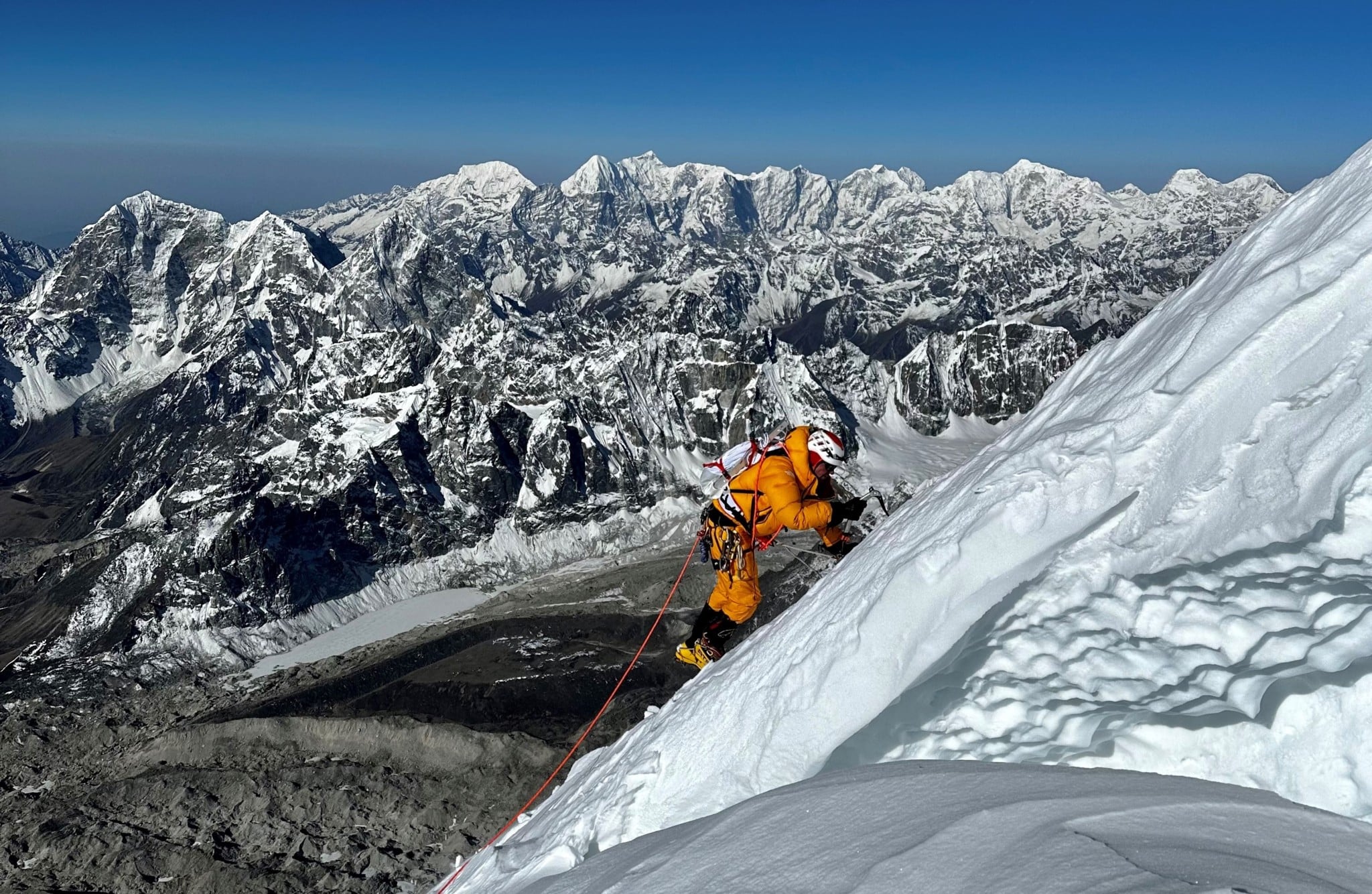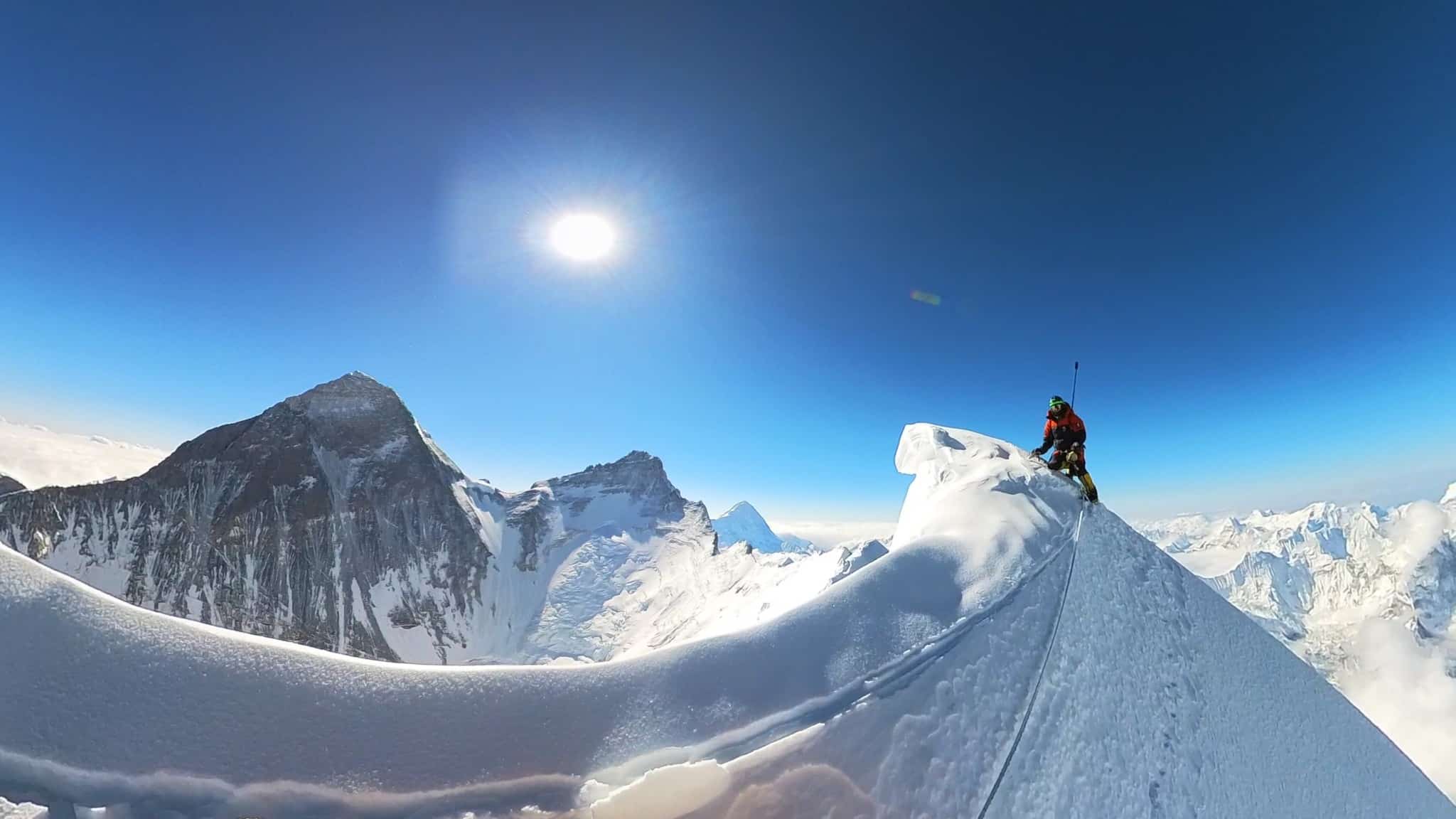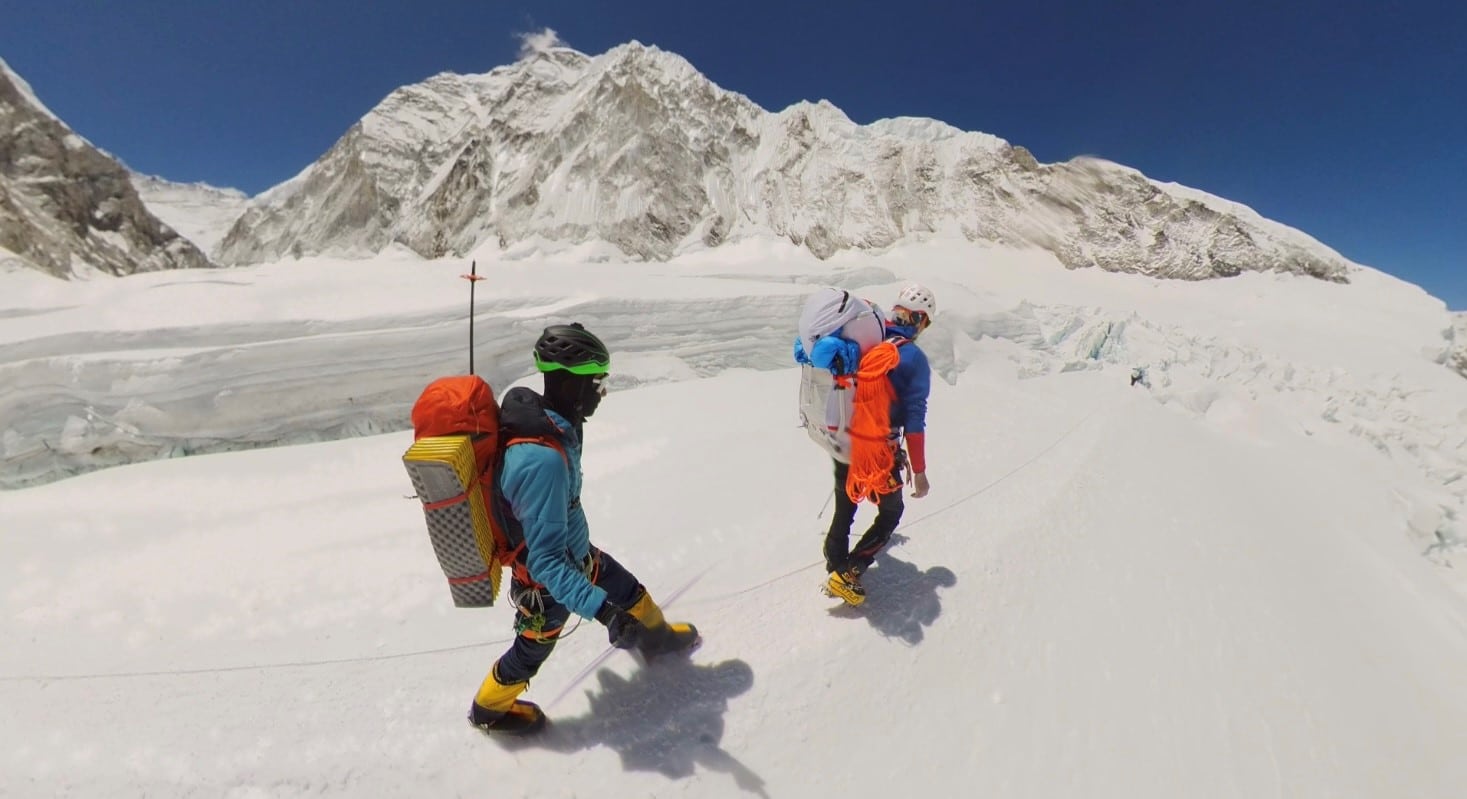On 21 May, Dutch mountaineer Christian De Jong made history in his country by becoming the first person to climb Nuptse. He also climbed Pumori one week before. Christian De Jong talks to us about his vision of Himalayan ascents in alpine style, his doubts about the mentality of some Everest aspirants, and his hopes for the future of the Sherpas.
Dutch mountaineer Christian De Jong, contacted by videoconference, spoke at length to Alpine Mag about his double ascent in alpine style of Pumori on 13 May 2023 , and Nuptse (the first in his country) on 21 May 2023. As well as his sporting and historic achievements, the mountaineer promotes an alpine style that is dear to him, and a practice that respects people and the environment. Interview.
Alpine Mag: How did the project to climb Pumori and Nuptse come about?
Christian De Jong: Last year we climbed the Kyajo Ri (6 189 m) and the Cholatse (6 440 m). I was really thinking about what I would want to climb because there’s a lot of options and I like to climb remote peaks. But then my friend Prakash really wanted to climb Nuptse because he had been on Nuptse before, up to 7 400 or 7 500. And he had some kind of unfinished business. And I thought, I’m not sure if an is going to be the right climb for me because it’s high up in the 7000. And I was not sure if I would be able to do so because it’s 7860, which is now almost 8000. But then I decided to just go for it and see if I would be able to, because both technicality and altitude would be a real challenge.
And then later on I read some more about Pumori. And the more I read, the more I was also intrigued by that mountain as well. It’s it’s a mountain with quite high objective danger, which kind of made me doubt whether I wanted to do it. But if you look at the shape of the mountain it looks so amazing. So we decided to add like two climbs into the whole project for acclimatization purposes. So we ended off in Nepal and I climbed Island Peak solo.
this crazy world called Everest base camp
How did it feel to be almost alone on the summit, whereas hundreds of Everest aspirants were crowding the mountain?
It’s crazy. I’ve not climbed many mountains in Nepal, but I have climbed six so far. And on all mountains. I’ve been alone like only with my climbing team. And it’s really amazing because Nepal is such a crowded place. But they all focus on a few mountains. That’s also why I’m not so interested in Amadablam or Everest, because everybody goes there. I go to the mountains to be in places where nobody is. And so it felt a little bit strange to go for Nuptse because you are in this crazy world called Everest base camp. And yeah, I’m also not sure if I ever want to go back to that place again because I love Nuptse. But the location and the place where you do your expedition from is a strange place. I’ve never seen such a thing in the mountains.
Many of the people, I would say, are not climbers. They want to go to Everest and they want to do something big in their lives. I’m not sure if I have a very strong opinion. It’s their choice. I don’t want to judge, but it’s different. It’s not climbing. It’s a little bit more mountain tourism. People who want to do the physical challenge but not caring about the mountains so much. What I love about climbers, they love mountains and they love the environment and they also care for the environment. But at the same time, everyone has their right for their own adventure. But I think from a government perspective, they should somehow limit the impact of all these climbers in the season.
I’m afraid that Everest ends up to be a mountain only for rich people and not for climbers anymore, because more and more climbers kind of avoid that place. And I do understand, but still, Nepal has a lot of beautiful places where you can actually be the only one at the summit. So I hope that’s also because Nepal needs the income. It’s still a very poor country and Everest is the moneymaker. But Everest is not the solution because if it’s going this way, if we keep on going this direction, then at some point you don’t want to be there anymore. Anyway.
What’s your relationship with Prakash Sherpa?
Prakash is a mountain guide. I do not climb with him as a mountain guide. We just climb together. I don’t do not pay him or whatsoever. We just climb as friends. I met him last year during our ascent of the 6000 meter peaks. I had a friend from the Netherlands. We climbed together and we were looking for some support in the Himalayas from someone who actually understood what it is to climb alpine style in the Himalayas. And Prakash is a mountain guide. He has his own guiding agency and he really wants to promote alpine style climbing in Nepal. But we said we don’t want guiding. We just want the support in the base camp and just all the logistics, the permits, the garbage disposal permits, all these kinds of things, you need someone. So last we just climbed together.
And I think for this year I also told him I had this plan and I wanted to go back to Nepal 7000 meters. But I’m not looking for a guide. I’m just looking for a climbing partner. And I was also looking for a climbing partner in the Netherlands, but I could not really find someone else who would be able to actually do what I wanted to do in terms of technicality or endurance strength. And then he said : “Well, I just want to go climbing with you and you don’t have to pay me. We just make a nice project out of it and let’s see”. So it’s kind of misunderstood, when I talk about our kind of relationship here as well, people think that he’s my Sherpa. I don’t believe he is my Sherpa because I don’t own him. I hate that when people say “he’s my Sherpa”. No, of course there’s someone who supports you, but it sounds like this Western kind of ownership. And I don’t like it.
Prakash and I, we just became very good friends. And actually our climbing level is kind of similar. But only Prakash is stronger in altitude because he is Nepali, and is so used to altitude. So I think for a Westerner, I am pretty strong in altitude, but he is still much stronger. And so for me, he is the perfect climbing partner. But I said to him I don’t want to have any guiding. We make the decisions together. We both lead the climb. I’m not like just following him, we do everything together. And that’s basically how we did it. Even though he is stronger. Like it felt totally equal.
it’s kind of modern slavery
How are Sherpas considered by Western mountaineers?
There is so much money and so much ego in Everest base camp from all these Western climbers. People say “that’s my Sherpa”. And you see people with the smallest daypack or not even a backpack going through the icefall, going from camp 1 to camp 2 or even higher up the mountain with some Sherpas behind with a huge backpack struggling to keep up. I don’t like the word, but it’s kind of modern slavery. It’s like “I paid €50,000 and that’s why I have the right that someone else does this work for me”. It’s often the lack of fitness or lack of understanding the mountain. Then they need to be compensated by someone who is actually very strong. And then, at the end of the expedition, they all say “I could not do it without my guide or without my sherpa”. Yeah, I am sure that you could not. But the way you actually behaved during the expedition, I’m not sure if that’s the right way to look at the Sherpa people.
Do you think the mentality concerning Sherpas is changing?
I think it goes two ways. On one hand, I think there are many more Nepali based guiding agencies with Nepali based guides. And I think that puts them in a higher ranking. So people are starting to look up to them more and more. And I think that’s the upside. That’s a very positive development, because back in the days it was always Western guides and then Sherpa people were only there to support. And now Sherpa people are also leading.
Nirmal Purja is one of these people who actually showed that Nepali also can be in the forefront. I think he is quite a specific type of person, but still, I think he put them on the map in some way. And what I really like also with a person like Prakash, he is actually a Dynafit athlete, so he’s an athlete for a European brand in the Himalayas, which is kind of funny, but it also shows that he’s not there just for the support. He is actually there for his own success as well. And that’s why he wanted to go climbing with me on these mountains. Because he did not summit Pumori or Nuptse so far and he just wanted to show that he can do these ascents.
a project in the Alps
What are your future projects?
I still want to go for 8000 meters because I had the permit for Lhotse as well this year. But after all these climbs and after Nuptse basically the time frame would be very short and the weather window was not ideal. So I would only have two rest days in camp 2. It’s almost 6 500 meters and I just knew I would never recover enough to ascend Lhotse which is still 8 500 meters, so it’s so high in the 8000 and I knew I would be able I think to climb up to 8000, maybe 8 100. I felt like I could do that, but I was pretty sure I would not be able to summit. And so still the 8000 project is there to be accomplished.
South face of Shishapangma (8 027 m) looks so amazing and there’s only a few climbers and all the routes are pretty hard and some are super hard. It’s by definition alpine style because there is no one there. And you have to do everything by yourself. So Shishapangma south face also because Shishapangma is relatively low in the 8000. That would be the perfect objective.
For next year I want to go for a project in the Alps. I have decided to climb all the 4000 meter peaks in the Alps in Switzerland, because I think all will be just too long, but only Switzerland will be 48. So it’s the majority of the 4000 meter peaks. Maybe I put into it the extra challenge of avoiding any normal route.






